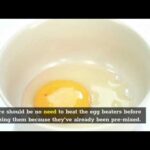Whipped egg whites have a fluffy, almost pillow-like texture that is extremely beneficial. Among their many uses, whipped egg whites help souffles and cakes rise, lighten pancakes and waffles, and can be sweetened and converted into meringue.
Many home cooks are intimidated by the notion of whipping egg whites, but it actually isn’t that difficult. This guide demonstrates how to whip them and explains the stages (soft peak, firm peak, stiff peak) so you can feel confident taking them on.
When you beat egg whites, you’re essentially forcing air into the whites, causing the protein to stretch and generate bubbles around the water. As you whip them, they progress through the following stages:
- oft peaks (you can remove the whisk or beaters and a peak will form, and then droop)
- Firm peaks (when you remove the whisk or beaters the peak that forms will keep its shape)
- Stiff peaks (not only does the peak on the egg white surface hold but so will the peak on the whisk or beaters when turned to peak upwards as shown above).
If you over-beat the egg whites, the stretched protein will break, allowing the water in the whites to escape, resulting in an unappealing mixture of eggy water and foam.
Start With Fresh Eggs and Separate Them
Fresh egg whites whip up faster and are more stable than older egg whites. When eggs are cold, they are easier to separate, but when they are at room temperature, they are easier to whip up. So, if you have the time, separate the eggs when they are cold and let the whites set out for approximately half an hour to remove the chill before whipping.
When separating the eggs, use extreme caution. Any yolk (or any fat, oil, or grease) in the whites will prevent them from whipping up as big and fluffy as they should be.
When separating a large number of eggs, consider utilizing the three-bowl method: one for cracking the egg, one for separating the whites, and one for separating the yolks. If you unintentionally break one, the collected whites won’t be tainted by the yolk.
While the copper ions help stabilize the egg whites (science is great! ), it is far from necessary to whip egg whites successfully, and the stabilizing power of the copper can be perfectly reproduced by adding a wee amount of cream of tartar to the whites, as stated in the next step. Any clean and large bowl would suffice.
What should I do with the egg yolks? Make a pudding or sauces similar to mayonnaise (aioli is another great option).
Add Salt and/or Cream of Tartar
Whip the eggs with a large clean whisk (a balloon whisk is even better) or clean beaters or the whisk attachment on a standing mixer just until frothy. Then, for every 2 to 4 egg whites, add a pinch of salt and/or cream of tartar; if you’re working with more than that, use 1/8 teaspoon for up to 8 whites and 1/4 teaspoon for up to a dozen. Salt and cream of tartar both work as stabilizers, allowing the egg whites to keep their shape while being whipped.
Remember to leave out the cream of tartar if you’re using a copper bowl. Also, if you don’t have cream of tartar on hand, don’t be concerned or run out to the grocery; many of egg whites have been whipped up without it!
Soft Peaks
The egg whites must now be whipped or beat. If you’re doing it by hand, work it vigorously in a large up-and-down circular motion to incorporate as much air as possible. If you’re using electric best egg beaters or a standing mixer, medium speed will amply beat the eggs while also allowing you to monitor their progress.
Soft peaks have formed here. When you remove the whisk or beaters from the whites, a peak emerges where the instrument used to be, but it quickly droops. When you’re only adding beaten egg whites to a dish to lighten it up, you want it to be at the soft peak stage (a useful trick with pancakes and waffles for extra fluffy, light-as-air results).
Firm Peaks
If you continue to beat the egg whites, they will swiftly transform from soft to hard peaks. Firm peaks, on the other hand, maintain their shape without drooping.
Stiff Peaks
If you keep going, you’ll soon have stiff peaks. As you can see from the whisk above, these egg whites hold their shape even when whirled upside down and round and round.
This is the final stage to which you should proceed. If you continue to whip the egg whites, they will first become dry, losing their glossy sheen, and then begin to pull apart a bit like ocean foam, and the protein strands you have so carefully stretched and filled with air will simply collapse and break apart, the water and protein in the egg whites will separate, and you will be left with a sad bowl of eggy water and clumps of foam.
Note: Whipped egg whites are delicate, so utilize them after you’ve whipped them! Remember that you’ve just beaten a load of air into them, and you want to maintain as much of that air in there as possible if the recipe calls for “folding” them into a batter or with another substance.
Rather than whisking everything together as usual, gently fold everything together by running the spatula along the bottom of the bowl and then up and over the batter and whites. It will take some patience to combine everything, but the lovely fluffiness of your finished meal will be worth it.
Was this helpful?
Hi there! I’m a food enthusiast and journalist, and I have a real passion for food that goes beyond the kitchen. I love my dream job and I’m lucky enough to be able to share my knowledge with readers of several large media outlets. My specialty is writing engaging food-related content, and I take pride in being able to connect with my audience. I’m known for my creativity in the kitchen, and I’m confident that I can be the perfect guide for anyone looking to take their culinary journey to the next level.








